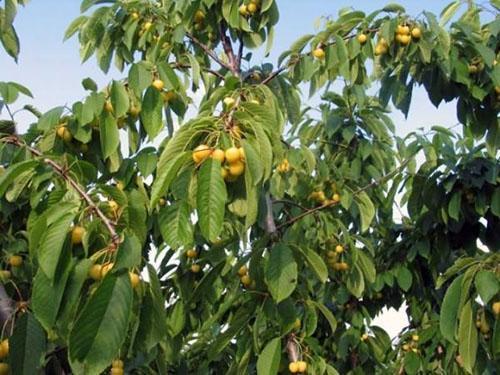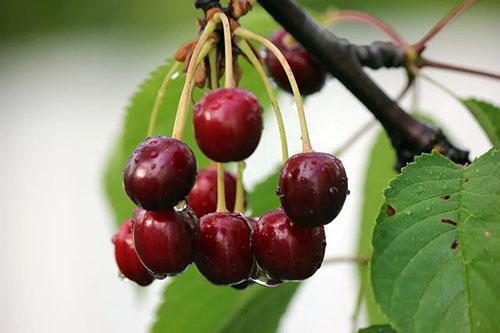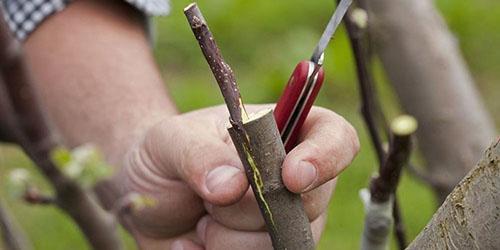Sweet cherry in the Moscow region - a conquered southerner
 Sweet cherry is a thermophilic culture; for a long time it did not succumb to the efforts of biologists seeking to create varieties for the middle climatic zone. Cherry took root in the Moscow region, thanks to the scientific feat of breeders of the Oryol, Bryansk and Moscow regions. At the end of the last century, the first cherry seedlings appeared in the gardens of summer residents. Nature promotes the introduction of culture into circulation. The climate has changed - the summer has become longer, there are more sunny days, and the winters are milder.
Sweet cherry is a thermophilic culture; for a long time it did not succumb to the efforts of biologists seeking to create varieties for the middle climatic zone. Cherry took root in the Moscow region, thanks to the scientific feat of breeders of the Oryol, Bryansk and Moscow regions. At the end of the last century, the first cherry seedlings appeared in the gardens of summer residents. Nature promotes the introduction of culture into circulation. The climate has changed - the summer has become longer, there are more sunny days, and the winters are milder.
Read also the article: why cherries are useful.
The advantages of cherries

Sweet cherry is a healthy berry. It has a beneficial effect on the digestive tract system, stimulates hematopoiesis, as it contains a lot of iron.
The southerner requires special conditions. But breeders received varieties that survive in frost up to 30 degrees without freezing. Active growth helps the cherry to quickly recover if the tree receives frost breaks in unfavorable years.
 The frost resistance of cherries in the Moscow region is increased by grafting:
The frost resistance of cherries in the Moscow region is increased by grafting:
- a winter-hardy cherry tree, Shubinka, Kind, is taken, a sweet cherry is grafted at a height of 1-1.5 meters;
- skeleton-forming - a young winter-hardy cherry is grafted into the conductor and skeletal branches.
As a result of the faster growth of the cherry scion, the junction becomes not the same in thickness after several years, the branch with the harvest may break off. Therefore, furrowing is carried out in order to achieve uniform development for the mother and daughter.
Due to the quick filling of berries, early fruiting, cherries go away from diseases typical of cherries. Despite the declared resistance of sweet cherry varieties to diseases, preventive measures must be taken.
Correct planting of cherries in the Moscow region
 Of all acclimatized fruit trees in the middle lane, cherries are the most demanding in terms of keeping conditions. It is the gardener's task to create a long day, protect it from the wind, and keep the root system in comfortable humidity. The future garden decoration is planted on the south side of the building, fence, or a baffle plate is installed. To increase the illumination, the reflective surface is painted white. The rest of the trees should not cast a shadow on the sissy, they are placed at least 7 meters.
Of all acclimatized fruit trees in the middle lane, cherries are the most demanding in terms of keeping conditions. It is the gardener's task to create a long day, protect it from the wind, and keep the root system in comfortable humidity. The future garden decoration is planted on the south side of the building, fence, or a baffle plate is installed. To increase the illumination, the reflective surface is painted white. The rest of the trees should not cast a shadow on the sissy, they are placed at least 7 meters.
The ripeness of a berry can be determined by its petiole. If the stalk is yellow, the berry has not gained sweetness, if it is brown, the berry is overripe, the taste is spoiled. Only green elastic petioles indicate that the product is in the juice itself.
Cherries are planted in the Moscow region in spring on raised ridges. The flowerbed is prepared in advance, in the fall. The soil should settle and compact. The mound warms up faster, even in heavy rains the earth will not turn into a swamp. The more severe the climate, the larger the area of the flower bed so that the roots do not freeze in winter.
When creating a flower bed, it is necessary to provide for drip irrigation. The flowerbed dries out faster, watering should take this into account. The mound must be sown with a grass mixture:
- clover;
- meadow fescue;
- phacelia;
- bluegrass is white.
The grass is regularly mowed, the ground is mulched with semi-rotted manure. Cherry receives enough nutrients, mineral nitrogen is not required.
 Planting cherries in the suburbs, like other thermophilic crops, is better in spring. The planting nest is being prepared in the fall:
Planting cherries in the suburbs, like other thermophilic crops, is better in spring. The planting nest is being prepared in the fall:
- the pit should be 60 cm deep, 80-100 cm wide;
- in autumn, pour a mixture of humus and garden soil, in spring, loosen the surface of the tubercle with a pitchfork;
- pour a liter jar on top ash, 2 cups superphosphate, mix the bottom layer;
- Before planting, hold the roots of the seedling in clean water for 10 hours, in a mash made of mullein and clay for 5 hours.
- plant so as not to deepen the root collar.
From above, the roots are sprinkled with garden soil without fertilizers, watered, the earth is mulched. Remember to place a stabilizing stake on the north side of the seedling. The seedling needs to be purchased in the nursery, zoned. Do not forget that cherries have little or no self-fertility. Further cultivation of cherries in the Moscow region is associated with regular watering, mowing of grass stands and mulching of the soil of the trunk circle.
 Rejoice if you managed to buy a columnar cherry sapling. There are still few of them. Short stem branches are strewn with berries, fruiting occurs in the year of planting, but it is better to remove the first flowers, let the tree gain strength.
Rejoice if you managed to buy a columnar cherry sapling. There are still few of them. Short stem branches are strewn with berries, fruiting occurs in the year of planting, but it is better to remove the first flowers, let the tree gain strength.
Column-shaped cherries for the Moscow region are still represented by several varieties - Helena, Sylvia.
They are combined in planting, grow 3 meters in height and annually present 12-14 kg of delicious berries. Trees are planted at a distance of 2.5 meters, no shaping is required. The declared period of fruiting of columnar cherries is 30 years. Shelter for the winter is necessary, since the winter hardiness of clonal cherries is average.
Cherry care during the growing season and protective measures
 When planting and caring for cherries in the Moscow region, a number of rules must be observed:
When planting and caring for cherries in the Moscow region, a number of rules must be observed:
- Watering the plants should be regular. It is enough to water the ground in the near-trunk circle 2 times a month, but if the summer is sultry - after 10 days. More often - ripe berries will crack, roots will begin to choke.
- You need to fertilize fruit trees only at the very beginning of May. Superphosphate increases winter hardiness and does not promote the growth of greenery, it can be used in September. Elongated twigs are prey for frost.
- Frost protection consists in wrapping the trunk with paper, geotextiles. No pruning in the fall. Flowering trees are sprayed with honey water, covered from frost, leaving gaps for the flight of bees.
- Pruning is done in early spring. Tops are removed and growth inside, thickening the crown. If there are dried, broken twigs, they are removed along the open foliage.
 Cherry care in the Moscow region should be balanced, commensurate with the weather conditions. The selection of varieties of different ripening periods, the presence of pollinators are indispensable conditions for obtaining stable yields of sweet berries.
Cherry care in the Moscow region should be balanced, commensurate with the weather conditions. The selection of varieties of different ripening periods, the presence of pollinators are indispensable conditions for obtaining stable yields of sweet berries.